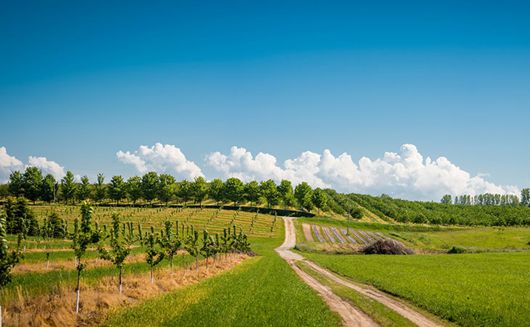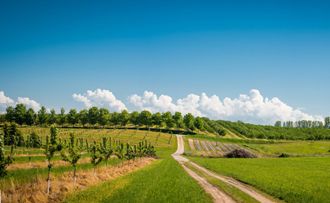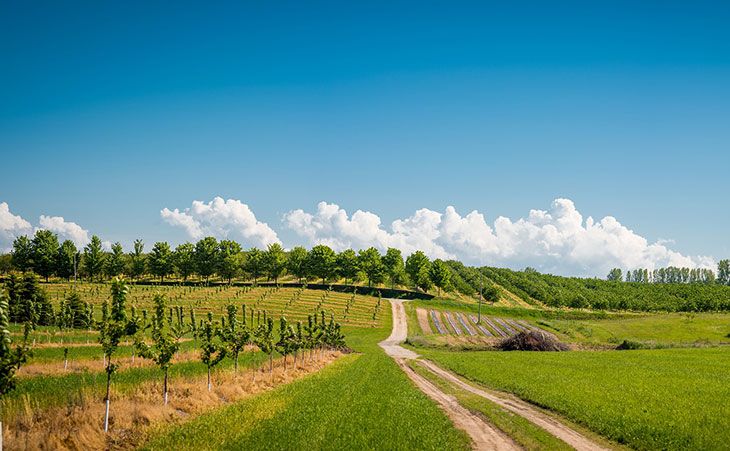Planning a Wholesale Orchard


Read about all the things you need to consider when planning a wholesale orchard, including tree density, rootstock, and variety vigor.
Modern Orchard Planning
The most important step in orchard establishment is “The Plan.” Profitable operations use varieties, rootstocks and planting densities to match the site, equipment and grower’s commitment.
Planting density and tree management have the greatest effect on an orchard’s efficiency. Density is the number of trees per unit of land (trees per acre). As density increases, so does the intensity of management. High density orchards (500+ trees/acre) on dwarf rootstocks require a high level of grower commitment, with a premium on timely tree training and pruning/water management.
Tree density should be designed to provide the maximum bearing capacity per acre with the least land waste. Trees should be spaced so that at maturity they will touch but not crowd, with space for machinery to move freely through the orchard.
The primary factors affecting mature tree size are variety vigor and rootstock size control. Other factors affecting mature size are climate, soil fertility, length of growing season, available water and light intensity.
Most of the orchard evolution from seedling to dwarf rootstocks has been linked to the financial benefits of high-density orchards. The precocity of dwarf rootstocks has brought orchards into production 3-5 years faster than semi-dwarfs, allowing a quicker return on capital investment. Increased tree density boosts returns per acre in the early years as well, because tree density is the single most important factor in early production.
Because choosing the proper rootstock and scion variety is key for desired density, the next sections will focus on how these variables affect the mature size of a tree and the planting density.
Tree Density Guide
Today, semi-dwarf orchards have densities of 123-311 trees per acre at spacings of 16' x 22' to 10' x 14'.
Dwarf orchards are planted with spacings as tight as 2' x 10', but more commonly 4' x 14' and up to 7' x 16' for densities of 388-777 trees per acre.
Standard orchards are no longer planted because they take too long to produce. Today, high density means more than 500 trees to the acre and will exceed 1000+ with multi-row systems.
Orchard Planning Chart
| Feet | 6 | 7 | 8 | 9 | 10 | 12 | 14 | 16 | 18 | 20 | 22 | 24 |
| 4 | 1815 | 1627 | 1361 | 1210 | 1089 | 907 | 777 | 680 | 605 | 544 | 495 | 453 |
| 5 | 1452 | 1240 | 1089 | 666 | 871 | 726 | 622 | 544 | 484 | 435 | 396 | 363 |
| 6 | 1218 | 1037 | 907 | 806 | 727 | 605 | 518 | 453 | 403 | 363 | 330 | 302 |
| 8 | 907 | 777 | 680 | 605 | 544 | 453 | 388 | 339 | 302 | 272 | 247 | 226 |
| 10 | 726 | 622 | 544 | 484 | 435 | 363 | 311 | 272 | 242 | 218 | 207 | 181 |
| 12 | 605 | 518 | 453 | 403 | 362 | 302 | 259 | 226 | 201 | 181 | 165 | 151 |
| 14 | 518 | 444 | 388 | 345 | 311 | 259 | 222 | 194 | 172 | 155 | 141 | 129 |
| 16 | 453 | 388 | 339 | 325 | 272 | 226 | 194 | 169 | 151 | 136 | 123 | 113 |
| 18 | 403 | 345 | 302 | 268 | 242 | 201 | 172 | 151 | 134 | 121 | 110 | 100 |
| 20 | 363 | 311 | 272 | 242 | 218 | 181 | 155 | 136 | 121 | 108 | 99 | 90 |
| 22 | 330 | 282 | 247 | 220 | 207 | 165 | 141 | 123 | 110 | 99 | 90 | 82 |
| 24 | 302 | 259 | 226 | 201 | 181 | 151 | 129 | 113 | 100 | 90 | 82 | 75 |
Planning the Optimum-Density Orchard
Rootstock and variety vigor are important components of proper planting distances. Rootstocks have the most influence on tree size and growth characteristics, so rootstock choice should match with the variety to produce the desired mature tree size. The characteristics imparted to the mature tree should also match the management and training system used.
Semi-dwarf rootstocks with less size control (Bud. 118, M-7, M-106) are usually best adapted to free standing central leader trees spaced at lower densities (100-300 trees/acre). The more size controlling dwarf rootstocks (Bud. 9, M-9 and M-26) are best adapted to supported (staked or trellised) trees spaced at medium-to-high densities (300-1000+ trees/acre).
Although the rootstock will have the greatest influence on the mature tree size, genetic factors such as vigor, precocity and growth habit will also have an influence.. On the same clonal rootstock, the mature size of different varieties can vary as much as 30%. For this reason, the apple varieties sold by Stark Bro’s have each been placed in a Variety Vigor Category (VVC). On any given rootstock, differences in mature tree size will vary with the VVC.
When varieties from different vigor categories are planted in the same orchard, it is important to consider these vigor differences, especially if choosing the closer of the recommended spacings. Adjusting the planting distances or selecting alternate rootstocks for chosen varieties may be advisable to compensate for the differences.
For example, a low vigor and a moderate vigor variety planted in the same orchard would require either different spacings (say 12' on the low vigor and 14' on the moderate vigor variety) or different rootstocks (say MM-111 on the low vigor and M-7 on the moderate vigor variety) with no change in spacing to yield equally per foot of row. If wider spacings are chosen compensation may not be necessary, but the lower vigor variety will take a few years longer to fill its space and some production will be sacrificed until it does.
Please keep in mind that these ratings are based on average variety and rootstock performance across different geographical regions. Some variations should be expected due to the tree’s individual
overall precocity, soil fertility, growing conditions and management.
- Article Categories:
- Ideas & Inspiration









































